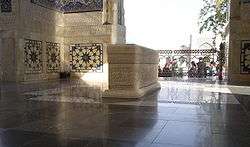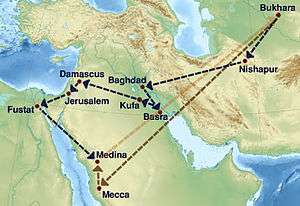Muhammad al-Bukhari
Abū ‘Abd Allāh Muḥammad ibn Ismā‘īl ibn Ibrāhīm ibn al-Mughīrah ibn Bardizbah al-Ju‘fī al-Bukhārī (Arabic: أبو عبد الله محمد بن إسماعيل بن إبراهيم بن المغيرة بن بردزبه الجعفي البخاري; 21 July 810 – 1 September 870), or Bukhārī (Persian: بخاری), commonly referred to as Imam al-Bukhari or Imam Bukhari, was a Persian[6][7][8] Islamic scholar who was born in Bukhara (the capital of the Bukhara Region (viloyat) of what is now Uzbekistan). He authored the hadith collection known as Sahih al-Bukhari, regarded by Sunni Muslims as one of the most authentic (sahih) hadith collections. He also wrote other books such as Al-Adab al-Mufrad.[9].
Muḥammad ibn Ismā‘īl al-Bukhārī | |
|---|---|
محمد بن إسماعيل البخاري | |
 al-Bukhārī's name in Arabic calligraphy. | |
| Title | Imam al-Bukhari Amir al-Mu'minin fi al-Hadith |
| Personal | |
| Born | 21 July 810 C.E. 13th Shawwal 194 A.H. Bukhara, Transoxiana (in present-day Uzbekistan) |
| Died | 1 September 870 (aged 60) C.E. 1 Shawwal 256 A.H. Khartank, near Samarqand |
| Resting place | Khartank (Samarkand, Uzbekistan) |
| Religion | Islam |
| Ethnicity | Persian |
| Era | Abbasid Caliphate |
| Denomination | Sunni |
| Jurisprudence | Shafi'i [1][2][3][4] |
| Main interest(s) | Hadith Aqidah |
| Notable work(s) | Sahih al-Bukhari al-Adab al-Mufrad |
| Occupation | Muhaddith, Hadith compiler, Islamic scholar |
| Muslim leader | |
Influenced by
| |
Influenced
| |
Imam al-Bukhārī | |
|---|---|
 Imam al-Bukhārī's mausoleum near Samarkand, Uzbekistan | |
| Hadith Traditionalist | |
| Venerated in | All traditional schools of Sunni Islam |
| Major shrine | Khartank (Samarkand, Uzbekistan). |
Biography
Birth
Muhammad ibn Ismaʿil al-Bukhari al-Juʿfi was born after the Jumu'ah prayer on Friday, 21 July 810 (13 Shawwal 194 AH) in the city of Bukhara in Transoxiana[10] (in present-day Uzbekistan).[6][11]
His father, Ismail ibn Ibrahim, a scholar of hadith, was a student and associate of Malik ibn Anas. Some Iraqi scholars related hadith narrations from him.[6]
Lineage
Imam Bukhari's great-grandfather, al-Mughirah, settled in Bukhara after accepting Islam at the hands of Bukhara's governor, Yaman al-Juʿfi. As was the custom, he became a mawla of Yaman, and his family continued to carry the nisbah of "al-Juʿfi".[6][11][12]
Al-Mughirah's father, Bardizbah, is the earliest known ancestor of Bukhari according to most scholars and historians. He was a Zoroastrian Magi, and died as such. As-Subki is the only scholar to name Bardizbah's father, who he says was named Bazzabah (Persian: بذذبه). Little is known of either Bardizbah or Bazzabah, except that they were Persian and followed the religion of their people.[6] Historians have also not come across any information on Bukhari's grandfather, Ibrahim ibn al-Mughirah.[6]
Hadith studies and travels
The historian al-Dhahabi described his early academic life:
He began studying hadith in the year 205 (A.H.). He memorized the works of [‘Abdullah] ibn al-Mubaarak while still a child. He was raised by his mother because his father died when he was an infant. He traveled with his mother and brother in the year 210 after having heard the narrations of his region. He began authoring books and narrating hadith while still an adolescent. He said, “When I turned eighteen years old, I began writing about the Companions and the Followers and their statements. This was during the time of ‘Ubaid Allah ibn Musa (one of his teachers). At that time I also authored a book of history at the grave of the Prophet at night during a full moon.[13]

At the age of sixteen, he, together with his brother and widowed mother, made the pilgrimage to Mecca. From there he made a series of travels in order to increase his knowledge of hadith. He went through all the important centres of Islamic learning of his time, talked to scholars and exchanged information on hadith. It is said that he heard from over 1,000 men, and learned over 600,000 traditions.
After sixteen years absence, he returned to Bukhara, and there he drew up his al-Jami' as-Sahih, a collection of 7,275 tested traditions, arranged in chapters so as to afford a basis for a complete system of jurisprudence without the use of speculative law.
His book is highly regarded among Sunni Muslims, and considered the most authentic collection of hadith, even ahead of the Muwatta Imam Malik and Sahih Muslim of Bukhari's student Muslim ibn al-Hajjaj. Most Sunni scholars consider it second only to the Quran in terms of authenticity. He also composed other books, including al-Adab al-Mufrad, which is a collection of hadiths on ethics and manners, as well as two books containing biographies of hadith narrators (see isnad).
Last years
In the year 864/250, he settled in Nishapur. It was in Nishapur that he met Muslim ibn al-Hajjaj. He would be considered his student, and eventually collector and organiser of hadith collection Sahih Muslim which is considered second only to that of al-Bukhari. Political problems led him to move to Khartank, a village near Samarkand where he died in the year 870/256.[14]
Mausoleum

Today his tomb lies within the Imam al-Bukhari Complex, in Hartang Village, 25 kilometers from Samarkand. It was restored in 1998 after centuries of neglect and dilapidation. The mausoleum complex consists of Imam al-Bukhari's tomb, a mosque, a madrassah, library, and a small collection of Qurans. Modern ground level mausoleum tombstone of Imam Bukhari is only a cenotaph, actual grave lies within a small burial crypt below the modern structure.[15]
Writings
Below is a summary of the discussion of Bukhari's available works in Fihrist Muṣannafāt al-Bukhāri by Umm 'Abdullāh bint Maḥrūs, Muḥammad ibn Ḥamza and Maḥmūd ibn Muḥammad.[16]
Works describing narrators of hadith
Bukhari wrote three works discussing narrators of hadith with respect to their ability in conveying their material: the "brief compendium of hadith narrators," "the medium compendium" and the "large compendium" (al-Tarikh al-Kabīr, al-Tarīkh al-Ṣaghīr, and al-Tarīkh al-Awsaţ). The large compendium is published and well-identified. The medium compendium was thought to be the brief collection and was published as such. The brief compendium has yet to be found.[17] Another work, al-Kunā, is on patronymics: identifying people who are commonly known as "Father of so-and-so". Then there is a brief work on weak narrators: al-Ḍu'afā al-Ṣaghīr.
Ṣaḥīḥ al-Bukharī & extant hadith
Two of Bukhari's works on hadith survive:
- Ṣaḥīḥ al-Bukharī – full title, al-Jāmi’ al-Musnad al-Sahīh al-Mukhtaṣar min umūr Rasûl Allāh wa sunnanihi wa ayyāmihi – "Collection of Selected True Reports of the Prophet, his Practices and Times"); al-Bukharī's famous magnum opus. [Note: these al-Musnad are reports with chains of narration that go back to the Prophet.]
- Al-Adab al-Mufrad ; hadith on respect and propriety...
School of thought
Bukhari has been claimed as a follower of the Hanbali school of thought within Islamic jurisprudence,[18] although members of the Shafi'i and Ẓāhirī schools levy this claim as well.[19]
Historical evidence suggests that Bukhari's legal positions were similar to those of the Ẓāhirīs and Hanbalis of his time, given the fact that Bukhari rejected qiyas and other forms of ra'y completely.[20] Bukhari's positions have even been compared to those of Ibn Hazm.[21]
Al-Dhahabi said that Imam Bukhari was a mujtahid, a scholar capable of making his own ijtihaad without following any Islamic school of jurisprudence in particular.
Early Islamic scholars
Early Islamic scholars | |||||||||||||||||||||||||||||||||||||||||||||||||||||||||||||||||||||||||||||||||||||||||||||||||||||||||||||||||||||||||||||||||||||||||||||||||||||||||||||||||||||||||||||||||||||||||||||||||||||||||||||||||||||||||||||||||||||||||||||||||||||||||||||||||||||||||||||||||||||||||||||||||||||||||||||||||||||||||||||||||||||||||||||||||||||||||||||||||||||||||||||||||||||||||||||||||||||||||||||||||||||||||||||||||||||||||||||||||||||||||||||||||||||||||||||||||||||||||||||||||||||||||||||||||||||||||||||||||||||||||||||||||||||||||||||||||||||||||||||||||||||||||||||||||||||||||||||||||||||||||||||||||||||||||||||||||||||||||||||||||||||||||||||||||||||||||||||||||||||||||||||||||||||||||||||||||||||||||||||||||||||||||||||||||||||||||||||||||||||||||||||||||||||||||||||||||||||||||||||||||||||||||||||||||||||||||||||||||||||||||||||||||||||||||||||||||||||||||||||||||||||||||||||||||||||||||||||
|---|---|---|---|---|---|---|---|---|---|---|---|---|---|---|---|---|---|---|---|---|---|---|---|---|---|---|---|---|---|---|---|---|---|---|---|---|---|---|---|---|---|---|---|---|---|---|---|---|---|---|---|---|---|---|---|---|---|---|---|---|---|---|---|---|---|---|---|---|---|---|---|---|---|---|---|---|---|---|---|---|---|---|---|---|---|---|---|---|---|---|---|---|---|---|---|---|---|---|---|---|---|---|---|---|---|---|---|---|---|---|---|---|---|---|---|---|---|---|---|---|---|---|---|---|---|---|---|---|---|---|---|---|---|---|---|---|---|---|---|---|---|---|---|---|---|---|---|---|---|---|---|---|---|---|---|---|---|---|---|---|---|---|---|---|---|---|---|---|---|---|---|---|---|---|---|---|---|---|---|---|---|---|---|---|---|---|---|---|---|---|---|---|---|---|---|---|---|---|---|---|---|---|---|---|---|---|---|---|---|---|---|---|---|---|---|---|---|---|---|---|---|---|---|---|---|---|---|---|---|---|---|---|---|---|---|---|---|---|---|---|---|---|---|---|---|---|---|---|---|---|---|---|---|---|---|---|---|---|---|---|---|---|---|---|---|---|---|---|---|---|---|---|---|---|---|---|---|---|---|---|---|---|---|---|---|---|---|---|---|---|---|---|---|---|---|---|---|---|---|---|---|---|---|---|---|---|---|---|---|---|---|---|---|---|---|---|---|---|---|---|---|---|---|---|---|---|---|---|---|---|---|---|---|---|---|---|---|---|---|---|---|---|---|---|---|---|---|---|---|---|---|---|---|---|---|---|---|---|---|---|---|---|---|---|---|---|---|---|---|---|---|---|---|---|---|---|---|---|---|---|---|---|---|---|---|---|---|---|---|---|---|---|---|---|---|---|---|---|---|---|---|---|---|---|---|---|---|---|---|---|---|---|---|---|---|---|---|---|---|---|---|---|---|---|---|---|---|---|---|---|---|---|---|---|---|---|---|---|---|---|---|---|---|---|---|---|---|---|---|---|---|---|---|---|---|---|---|---|---|---|---|---|---|---|---|---|---|---|---|---|---|---|---|---|---|---|---|---|---|---|---|---|---|---|---|---|---|---|---|---|---|---|---|---|---|---|---|---|---|---|---|---|---|---|---|---|---|---|---|---|---|---|---|---|---|---|---|---|---|---|---|---|---|---|---|---|---|---|---|---|---|---|---|---|---|---|---|---|---|---|---|---|---|---|---|---|---|---|---|---|---|---|---|---|---|---|---|---|---|---|---|---|---|---|---|---|---|---|---|---|---|---|---|---|---|---|---|---|---|---|---|---|---|---|---|---|---|---|---|---|---|---|---|---|---|---|---|---|---|---|---|---|---|---|---|---|---|---|---|---|---|---|---|---|---|---|---|---|---|---|---|---|---|---|---|---|---|---|---|---|---|---|---|---|---|---|---|---|---|---|---|---|---|---|---|---|---|---|---|---|---|---|---|---|---|---|---|---|---|---|---|---|---|---|---|---|---|---|---|---|---|---|---|---|---|---|---|---|---|---|---|---|---|---|---|---|---|---|---|---|---|---|---|---|---|---|---|---|---|---|---|---|---|---|---|---|---|---|---|---|---|---|---|---|---|---|---|---|---|---|---|---|---|---|---|---|---|---|---|---|---|---|---|---|---|---|---|---|---|---|---|---|---|---|---|---|---|---|---|---|---|---|---|---|---|---|---|---|---|---|---|---|---|---|---|---|---|---|---|---|---|---|---|---|---|---|---|---|---|---|---|---|---|---|---|---|---|---|---|---|---|---|---|---|---|---|---|---|---|---|---|---|---|---|---|---|---|---|---|---|---|---|---|---|---|---|---|---|---|---|---|---|---|---|---|---|---|---|---|---|---|---|---|---|---|---|---|---|---|---|---|---|---|---|---|---|---|---|---|---|---|---|---|---|---|---|---|---|---|---|---|---|---|---|---|---|---|---|---|---|---|---|---|---|---|---|---|---|---|---|---|---|---|---|---|---|---|---|---|---|---|---|---|---|---|---|---|---|---|---|---|---|---|---|---|---|---|---|---|
| |||||||||||||||||||||||||||||||||||||||||||||||||||||||||||||||||||||||||||||||||||||||||||||||||||||||||||||||||||||||||||||||||||||||||||||||||||||||||||||||||||||||||||||||||||||||||||||||||||||||||||||||||||||||||||||||||||||||||||||||||||||||||||||||||||||||||||||||||||||||||||||||||||||||||||||||||||||||||||||||||||||||||||||||||||||||||||||||||||||||||||||||||||||||||||||||||||||||||||||||||||||||||||||||||||||||||||||||||||||||||||||||||||||||||||||||||||||||||||||||||||||||||||||||||||||||||||||||||||||||||||||||||||||||||||||||||||||||||||||||||||||||||||||||||||||||||||||||||||||||||||||||||||||||||||||||||||||||||||||||||||||||||||||||||||||||||||||||||||||||||||||||||||||||||||||||||||||||||||||||||||||||||||||||||||||||||||||||||||||||||||||||||||||||||||||||||||||||||||||||||||||||||||||||||||||||||||||||||||||||||||||||||||||||||||||||||||||||||||||||||||||||||||||||||||||||||||||
References
Citations
- Lucas, Scott C. (2006). "The Legal Principles of Muhammad B. Ismāʿīl Al-Bukhārī and Their Relationship to Classical Salafi Islam". Islamic Law and Society. 13 (3): 292.
- Lucas, Scott C. (2006). "The Legal Principles of Muhammad B. Ismāʿīl Al-Bukhārī and Their Relationship to Classical Salafi Islam". Islamic Law and Society. 13 (3): 303.
- Lucas, Scott C. (2006). "The Legal Principles of Muhammad B. Ismāʿīl Al-Bukhārī and Their Relationship to Classical Salafi Islam". Islamic Law and Society. 13 (3): 290.
- Lucas, Scott C. (2006). "The Legal Principles of Muhammad B. Ismāʿīl Al-Bukhārī and Their Relationship to Classical Salafi Islam". Islamic Law and Society. 13 (3): 312.
- Ibn Rāhwayh, Isḥāq (1990), Balūshī, ʻAbd al-Ghafūr ʻAbd al-Ḥaqq Ḥusayn (ed.), Musnad Isḥāq ibn Rāhwayh (1st ed.), Tawzīʻ Maktabat al-Īmān, pp. 150–165
- Salaahud-Deen ibn ʿAlee ibn ʿAbdul-Maujood (December 2005). The Biography of Imam Bukhaaree. Translated by Faisal Shafeeq (1st ed.). Riyadh: Darussalam. ISBN 9960969053.
- Bourgoin, Suzanne Michele; Byers, Paula Kay, eds. (1998). "Bukhari". Encyclopedia of World Biography (2nd ed.). Gale. p. 112. ISBN 9780787625436.
- Lang, David Marshall, ed. (1971). "Bukhārī". A Guide to Eastern Literatures. Praeger. p. 33.
- Al-Adab al-Mufrad
- "Encyclopædia Britannica".
- Melchert, Christopher. "al-Bukhārī". Encyclopaedia of Islam, THREE. Brill Online.
- Robson, J. (24 April 2012). "al-Bukhārī, Muḥammad b. Ismāʿīl". Encyclopaedia of Islam, Second Edition. Brill Online.
- Tathkirah al-Huffath, vol. 2, pg. 104-5, al-Kutub al-‘Ilmiyyah edition
- Tabish Khair (2006). Other Routes: 1500 Years of African and Asian Travel Writing. Signal Books. pp. 393–. ISBN 978-1-904955-11-5.
- "Tomb of Imam al-Bukhari". Madain Project. Retrieved 12 May 2019.
- Fihris Muṣannafāt al-Bukhāri, pp. 9-61, Dār al-'Āṣimah, Riyaḍ: 1410.
- Fihris Musannafāt al-Bukhāri, pp. 28-30.
- Imam al-Bukhari. (d. 256/870; Tabaqat al-Shafi'iya, 2.212-14 [6])
- Falih al-Dhibyani, Al-zahiriyya hiya al-madhhab al-awwal, wa al-mutakallimun 'anha yahrifun bima la ya'rifun Archived 3 July 2013 at the Wayback Machine. Interview with Abdul Aziz al-Harbi for Okaz. 15 July 2006, Iss. #1824. Photography by Salih Ba Habri.
- Lucas, Scott C. (2006). "The Legal Principles of Muhammad B. Ismāʿīl Al-Bukhārī and Their Relationship to Classical Salafi Islam". Islamic Law and Society. 13 (3): 290–292, 303.
- Lucas, Scott C. (2006). "The Legal Principles of Muhammad B. Ismāʿīl Al-Bukhārī and Their Relationship to Classical Salafi Islam". Islamic Law and Society. 13 (3): 290, 312.
Sources
- Bukhari, Imam (194-256H) اللإمام البُخاري; An educational Encyclopedia of Islam; Syed Iqbal Zaheer
Further reading
| Wikisource has the text of the 1911 Encyclopædia Britannica article Bukhārī. |
| Arabic Wikisource has original text related to this article: |
Primary
- Encyclopedia of Sahih Al-Bukhari by Arabic Virtual Translation Center (New York 2019, Barnes & Noble ISBN 9780359672653)
- al-Bukhārī, al-Jāmiʿ al-ṣaḥīḥ, 9 vols. In 3, Būlāq 1311–3, repr. Liechtenstein 2001
- al-Bukhārī, al-Taʾrīkh al-kabīr, 4 vols. In 8, Hyderabad 1358–62/1941–5, 1377/19582
- al-Dhahabī, Taʾrīkh al-Islām, ed. ʿUmar ʿAbd al-Salām Tadmurī (Beirut 1407–21/1987–2000), 19 (251–60 A.H.):238–74
- Ibn Abī Ḥātim, K. al-Jarḥ wa-l-taʿdīl, 4 vols. In 8, Hyderabad 1360/1941
- Ibn ʿAdī al-Qaṭṭān, al-Kāmil fī ḍuʿafāʾ al-rijāl, ed. ʿĀdil Aḥmad ʿAbd al-Mawjūd et al., Beirut, 1418/1997
- Ibn ʿAdī al-Qaṭṭān, Asāmī man rawā ʿanhum Muḥammad b. Ismāʿīl al-Bukhārī, ed. ʿĀmir Ḥasan Ṣabrī, Beirut, 1414/1994
- Ibn ʿAsākir, Taʾrīkh madīnat Dimashq, ed. Muḥibb al-Dīn Abī Saʿīd al-ʿAmrawī, 70 vols., Beirut 1415/1995
- Ibn Ḥajar, Fatḥ al-bārī, ed. ʿAbd al-ʿAzīz b. ʿAbdallāh Ibn Bāz, 15 vols. Beirut, 1428–9/2008
- al-Khaṭīb al-Baghdādī, Taʾrīkh Baghdād aw Madīnat al-Salām (Cairo 1349/1931), 2:4–34
- al-Khaṭīb al-Baghdādī, Taʾrīkh Madīnat al-Salām, ed. Bashshar ʿAwwād Maʿrūf (Beirut 1422/2001), 2:322–59
- al-Nawawī, Tahdhīb al-asmāʾ wa-l-lughāt, Cairo 1927
- al-Qasṭallānī, Irshād al-sārī Ṣaḥīḥ al-Bukhārī, ed. Muḥammad ʿAbd al-ʿAzīz al-Khālidī, 15 vols., Beirut 1416/1996.
Studies
- Ghassan Abdul-Jabbar, Bukhari, London, 2007
- Muḥammad ʿIṣām ʿArār al-Ḥasanī, Itḥāf al-qāriʾ bi-maʿrifat juhūd wa-aʿmāl al-ʿulamāʾ ʿalā Ṣaḥīḥ al-Bukhārī, Damascus 1407/1987
- Jonathan Brown, The canonization of al-Bukhārī and Muslim, Leiden 2007
- Eerik Dickinson, The development of early Sunnite ḥadīth criticism, Leiden 2001
- Mohammad Fadel, "Ibn Ḥajar’s Hady al-sārī," JNES 54 (1995), 161–97
- Johann W. Fück, "Beiträge zur Überlieferungsgeschichte von Bukhārī’s Traditionssammlung," ZDMG 92 (n.s. 17, 1938), 60–87
- Ignaz Goldziher, Muslim studies, ed. S. M. Stern, trans. C. R. Barber and S. M. Stern (Chicago 1968–71), 2:216–29
- Nizār b. ʿAbd al-Karīm b. Sulṭān al-Ḥamadānī, al-Imām al-Bukhārī, Mecca 1412/1992
- al-Ḥusaynī ʿAbd al-Majīd Hāshim, al-Imām al-Bukhārī, Cairo n.d.
- Abū Bakr al-Kāfī, Manhaj al-Imām al-Bukhārī, Beirut 1421/2000
- Najm ʿAbd al-Raḥmān Khalaf, Istidrākāt ʿalā Taʾrīkh al-turāth al-ʿArabī li-Fuʾād Sizkīn fī ʿilm al-ḥadīth (Beirut 1421/2000), 135–264
- Scott C. Lucas, "The legal principles of Muḥammad b. Ismāʿīl al-Bukhārī and their relationship to classical Salafi Islam," ILS 13 (2006), 289–324
- Christopher Melchert, "Bukhārī and early hadith criticism," JAOS 121 (2001), 7–19
- Christopher Melchert, "Bukhārī and his Ṣaḥīḥ," Le Muséon 123 (2010), 425–54
- Alphonse Mingana, An important manuscript of the traditions of Bukhārī, Cambridge 1936
- Rosemarie Quiring-Zoche, "How al-Bukhārī’s Ṣaḥīḥ was edited in the Middle Ages. ʿAlī al-Yūnīnī and his rumūz," BEO 50 (1998), 191–222
- Fuat Sezgin, Buhârî’nin kaynakları, Istanbul 1956
- Umm ʿAbdallāh bt. Maḥrūs al-ʿAsalī et al., Fihris Muṣannafāt al-Imām Abī ʿAbdallāh Muḥammad b. Ismāʿīl al-Bukhārī…fīmā ʿadā al-Ṣaḥīḥ, Riyadh 1408/1987–8